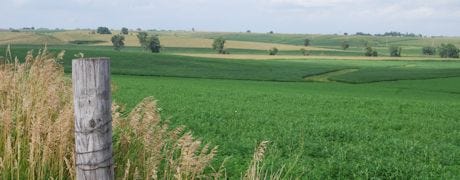October 11, 2013

This time of year there are always questions on when that last cutting of alfalfa could be made—or should be made—and still allow enough time for the plants to build root reserves of carbohydrate before the first killing frost.
The answers to these questions are usually something like… "It's fine to harvest alfalfa through the first week of September", and… "we recommend harvesting alfalfa at least 6 weeks before the killing frost." On average, a typical killing frost (25oF) in northeast Iowa occurs in the third week of October, says Brian Lang, Iowa State University Extension field agronomist at Decorah in northeast Iowa.

ALFALFA FALL HARVEST: Is it best to make the final cutting of alfalfa right before the first killing frost hits in fall? Or should you make the final harvest immediately after first fall frost hits? October 15 has been a good cut-off date--if killing frost hasn't occurred yet, it likely will soon, and weather in late October is usually cold enough that 200 GDD will not accumulate in the time remaining in the fall.
While those "good old answers" still work, the more correct answer actually deals with growing degree days or GDD, not the calendar, says Lang. Researchers now define a risk assessment of fall harvest of alfalfa based on alfalfa GDD. The research basically says as long as the plants accumulate at least 500 GDD from harvest to killing frost, the crop will have stored enough carbohydrate in the roots to survive the winter.
Latest research says you need to accumulate at least 500 growing degree days from harvest until time of first killing frost
A summary of this alfalfa research is available at the following web site from the University of Wisconsin. The data from Lancaster and Beloit (southern Wisconsin) would apply quite nicely to northeast Iowa, says Lang. Here's the website.
The Lancaster & Beloit data suggest alfalfa harvested through the first week of September is very low risk of winter injury, having plenty of time to replenish root carbohydrates going into the winter. A September 15 harvest could start providing some risk, and a September 21 harvest even more risk.~~~PAGE_BREAK_HERE~~~
"These risks do not mean that you will lose the entire stand, but rather would likely lose a percentage of the plants and would have a reduction in the first crop's yield next season--because of winter injury and slowed plant recovery in spring," says Lang. "And with this fall being so much warmer, the mid-September harvest dates have even less risk associated with them."
October 15 has been a good cutoff date for northern Iowa farmers, for taking final cutting of alfalfa
What if you chose to harvest your final cutting of alfalfa "after the killing frost"? This Wisconsin research says as long as the plants do not accumulate more than 200 GDD after harvest to before the killing frost, the plants should still overwinter just fine. This means that you do not have to wait for the actual killing frost to occur as long as you are roughly within a week or two of it when you harvest the alfalfa.
That's why October 15 has been a good cut-off date, as a rule of thumb--if the killing frost has not occurred yet, it likely will soon, and the weather in late October is usually cold enough that 200 GDD will not accumulate in the time remaining in the fall. A critical issue with harvesting after a killing frost is that little to no regrowth will occur following the harvest, notes Lang, so you want to cut high, leaving a good stubble height (approximately 6 inches) to help trap snow and insulate the plants during winter.
Manage sorghum-sudan carefully following frost; you want to avoid prussic acid poisoning
These crops require 28 F for a killing frost, however even a "light" frost requires special management. Prussic acid accumulates in the frosted tissue within a few hours after thawing and wilting, explains Lang. A "light" frost may damage just the tops of plants. If this occurs, delay grazing or harvest it a few days after frost to allow the prussic acid to dissipate from the plant tops. Livestock can be returned to frost injured sudangrass (18 inches or taller) and sorghum-sudan (28 inches or taller) once the frost-damage parts of the forage dry-out, usually 7 to 10 days.~~~PAGE_BREAK_HERE~~~
Sometimes a "light" frost enhances development of young shoots from the base of the plants. If this occurs, Lang advises you to delay sending livestock to graze this forage since these new shoots would be high in prussic acid. Ideally, wait for the new shoots to get to a proper grazing height (sudangrass 18 inches or taller and sorghum-sudan 28 inches or taller), but more than likely a complete killing frost will occur before that would happen. Once a complete killing frost occurs, wait until the frosted tissue is drying out (usually 7 to 10 days) before grazing or harvest.
If you are haying this forage, says Lang, the curing process decreases the prussic acid content as much as 75%, which removes the feeding concern. However, haying these forages this late in the season is nearly impossible because of poor dry-down conditions. If green-chopping the forage, chop only as much forage as the cattle will consume in 4 to 5 hours. "Never green-chop the forage and let it sit on the wagon overnight," he says.
If ensiling, harvest at proper moisture for your storage structure to ensure good fermentation, he adds. Good fermentation takes a minimum of 4 weeks. The fermentation process will reduce the prussic acid content. Since immature plants can contain higher prussic acid levels, leave this forage ferment for at least 8 weeks before feeding. Never allow horses to graze sorghums or sudangrass at any time.
You May Also Like




